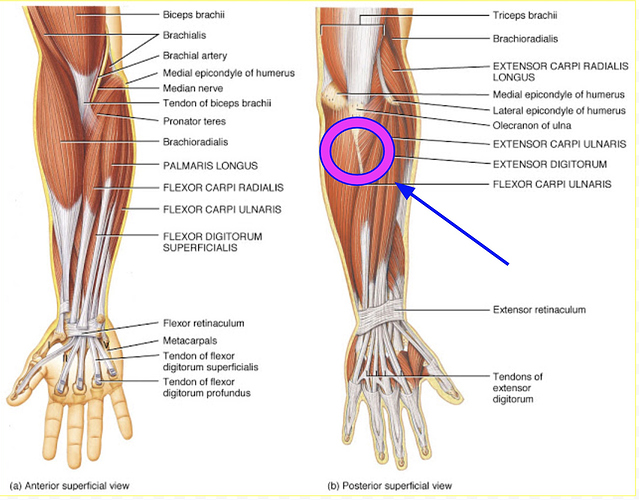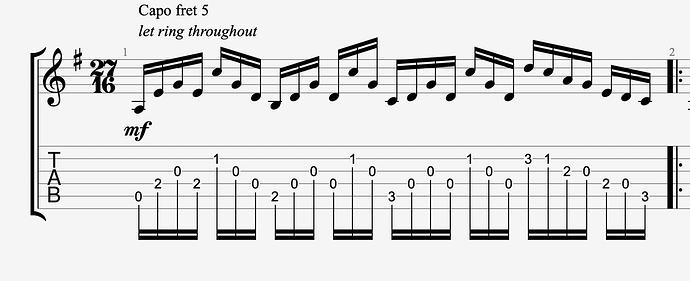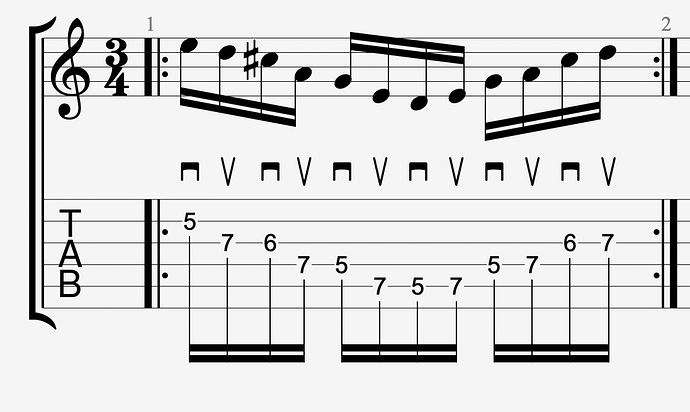I LOVE this example! It’s a great companion to the riding a bike example.
Ok, so…I have been toying around with this but running into a few issues, most notably forearm pain.
When I try to just ‘go for it’ I end up with kind of the same thing I was struggling with from roughly 2016-2019; nothing quite feels right, I’m never really getting any positive feedback. It’s either tight and locked up with zero endurance, or it’s no perceivable escaping.
I don’t get much pain while doing it, which is of course problematic because in the moment it doesn’t necessarily feel like I’m doing anything wrong.
But shortly after, tightness, soreness kicks in.
I tried to snag a pic to show where the pain occurs.
Any thoughts on this, anyone?
Much or any? There should be none. If there’s any, maybe something is wrong. In general, I wouldn’t hyper-focus on doing one-note-per-string stuff. It’s not really the fastest way to become good at one note per string stuff, ironically. There’s just not enough variety there to learn from. You need to eat a balanced diet.
When you play other stuff, do you use wrist motion, or some other type motion? What does that look like? Does it cause any of these issues?
What is the end goal here, what kind of lines are you trying to be able to play, let’s say, a year from now?
I’m not really sure what I do overall - seems to look like different things for different types of figures.
jazz/improv (mostly economy) https://www.instagram.com/p/CQ84pIliWRe/
jazz/improv (mostly economy) more hand: https://www.instagram.com/p/B_h58LnHfAv/
usX and ascending sweeps https://www.instagram.com/p/CJTqIbpi9oT/
usX alt line https://www.instagram.com/p/CJEdYPaijxN/
‘gunning’ https://www.instagram.com/p/CGoS7uwn7Ei/
string skips https://www.instagram.com/p/B-ue_ZoHabi/
bach, economy https://www.instagram.com/p/BvIUVCMBbb8/
Sometimes I’ll dig into some USX specific things because I know I can use that orientation for fast stuff, and I do find some of that same elbow pain if I’m hammering away at that for a while.
So I had to give this a real think, hence the months long gap here. I think it comes down to a few things:
there is, and always has been, a lot of odd time/odd grouping kind of ideas that I create that usually have bigger intervals, and I’d like to be able to play in a smooth, even way, with my own choice about accents.
There’s a lot of more nuanced interaction of variables between things I compose, ideas that I want to come out when I improvise, and music from others that I want to be able to play and incorporate into my own ideas. It just comes down to a confidence that i have that a lot of dynamic related and tempo related problems I run into would be solved if I had a good dbx motion going.
I might argue my interest in DBX is mainly about options for dynamics and tone, because I actually feel pretty confident being able to play more or less ‘anything’ with the bag of tricks I already have… with the very significant asterisks of A. having to choose very specific fingerings that may not produce the ideal timbres I have in mind and B. at a quick speed, having to accept accents and dynamics that are more so a result of the physical orientation of the line rather than the accents I would musically choose.
So I see more comfort and control with a DBX motion to be, at minimum, a useful problem solving tool even for things that don’t require a ton of it.
Re the personal ideas, odd groupings things, here’s an example, an idea I was goofing with over the past few days that I kind of like:
the piece continues with that rhythmic figure, basically, but chords change. It’s 7+6+7+7.
- if I use my right hand fingers I don’t really get the tone I want
- re-fingering would prevent the notes from ringing out
- if I used some sweeps as opposed to all-alt it would probably be a little easier for me tempo wise, but the bottleneck will still be parts that aren’t quite sweepable (like all the jumps from the 4th string to 2nd string) and I know I won’t have control of the dynamics and exact timing as well as i do with alt.
There are a bunch of other interests in the DBX thing though that are basically separate from anything I’d actually want to perform or record…intellectual interest, general personal challenge, interested in how my own development of the technique can help me help my students with their picking struggles, etc.
I hear this for sure - my main thing is that the 1nps things seem to be the white whale of my own picking technique, where pretty much everything else doesn’t present too many challenges anymore. So when I’m doing something that’s not so 1nps-heavy, if I’m picking every note it’s going to revert into a two way slanting thing or an economy thing, and then I guess I’m not really practicing DBX when i’m doing that.
Big shrug! Thanks as always.
“White whaling” is a term we should coin right now if it doesn’t already exist. It’s a negative because it leads to gradually over-emphasizing one type of phrase, resulting in less variety in stuff one attempts to play, resulting, ironically in less progress in the obsessed-about phrase.
It sounds like you don’t want to learn “DBX”, per se, because you don’t really care what kind of pickstroke you’re making. You just want to be able to play whatever line with alternate picking with what feels like “one technique” to you.
This is how wrist technique works, generally. By any chance have you watched this short video yet in our last update? If you get a moment, check this out:
The way this works, you choose one of these three forms, and that’s it. You keep everything in that position and just move your hand back and forth to create the motion. You don’t roll your arm around, or do “two way” anything as far as your general form is concerned. You simply train the hand to change its direction of motion to create the different escapes by trying to play as a wide a variety of your desired phrases as possible, regardless of number of notes per string. Obviously, this is still “two-way” in terms of the escape, but it’s just being done by the hand, not via form changes with the foreararm, fingers, etc.
The end result looks like this clip we put up on Instagram recently where I’m doing the pentatonic scale in both directions:
You can see, especially in the medium speed clip where the motions are larger, that the pick’s escape path just does whatever is necessary, while the arm position doesn’t change. The pick also doesn’t appear to have a pickslant, but, of course, the motions are slanted or curved, as needed.
It took us years to figure out that this is how this all works: that there are (generally) three forms of this, that they don’t use a pickslant, but that the motions can still be slanted because they are pretty flat / shallow, and that the motions themselves are very much a mix and match that isn’t very visible without a camera. Some techniques, like Gypsy technique, are more obvious. This type of playing is not.
But now that you know this, you can just choose one of the three forms. Or you can experiment with all three, and see how far you get. I’ve been speaking to Ben Eller about this and he basically does all three depending on the phrase he’s playing. And he’s very good at the pronated one, where the thumb is the anchor — he can play whole odd-numbered phrases that way. He just wasn’t aware he was doing it, or that this was a thing he should capitalize on and do more of. It’s very stealthy that way. As GI Joe says, knowing is half the battle.
Ok cool, cool, so, watched those wrist vids, rewatched some other stuff.
Here’s a clip from today of an easy phrase that has both types of escape
it’s about 10 seconds normal speed, 10 seconds slow, the rest is super slow.
Looks like the escaped downstrokes are barely escaping, but definitely escaping (I think?)
Seems like the more subtle wrist change you mentioned, but I see maybe a bit more pick slant, but that doesn’t matter?
Update on the pain stuff, been following your advice on ‘no pain’ as opposed to accepting some discomfort, paying close attention to anything that feels even a little bit off or extra tight, and that’s been helpful.
Oh, @Troy I omitted the important part. my question is: in today’s clip am I doing what you describe re wrist movement and both escapes?
Nice playing. Short answer is I don’t know. You’re definitely switching the escape here, so that you’re only doing the escape that is needed. There’s a little swiping here but the first order of business is whether it’s fast and smooth and sounds good, and you’re passing that test.
Whether you’re playing the line by altering the arm position, or by altering the wrist motion, that I can’t say. There is definitely a change in arm position, but that doesn’t mean that you’re not also changing to a different wrist motion. One thing you can do is try to force the arm not to change its position / rotation. You can try looking in a mirror to see if you can see the arm rotating. This is tough to do — once these things become learned it’s tough to shut them off because you can’t feel them. Make believe your arm is in a cast and can’t move. Don’t tense it up. Just don’t have any motion there.
Another test you can try, if you slow this down a small amount, does it start to look a little more like double escape? No? How about a little slower? You can see in my clip above, that’s what happens eventually when it gets slow enough. That would be an indication that you do know how to make more than one wrist motion, and that when you go fast like this, your hands are just optimizing because the other motions aren’t needed.
These types of 2nps lines will only teach you up to a point, because once you can play them smoothly and cleanly, there’s no way to know which motion you’re making. i.e. If there’s no stringhopping, nothing feels “wrong” so there’s nothing to “fix”. Not really a bad problem to have, i.e. being able to play the line.
Ultimately, if you want to learn a certain kind of motion, you have to play a phrase that requires it and where it will feel noticeably “wrong” when you don’t do it. So I would just let the phrases be your guide.




